
 Royal Navy Former 1892 Cunard RMS Campania. Converted Aircraft/Seaplane Carrier 1914-1918.
Royal Navy Former 1892 Cunard RMS Campania. Converted Aircraft/Seaplane Carrier 1914-1918.
HMS Campania was the former Cunard transatlantic, blue ribbon winner and record holder in 1897 with already a well filled and prestigious civilian carrer in 1914. She served at first as troopship and auxiliary cruiser due to her high speed when purchased by the RN in October. However not long after it was decided to take her for aircraft launching and recovery tests with a 160-foot flying-off deck mounted in top of the forward superstructure, and other modifications in 1915 and 1916-17 both to operate seaplanes and undercarriage models, making her, truly, the world’s first aircraft carrier, now a bit forgotten. #ww1 #royalnavy #britishfleet #grandfleet #aircraftcarrier #shortcampania #cunard #rmscampania
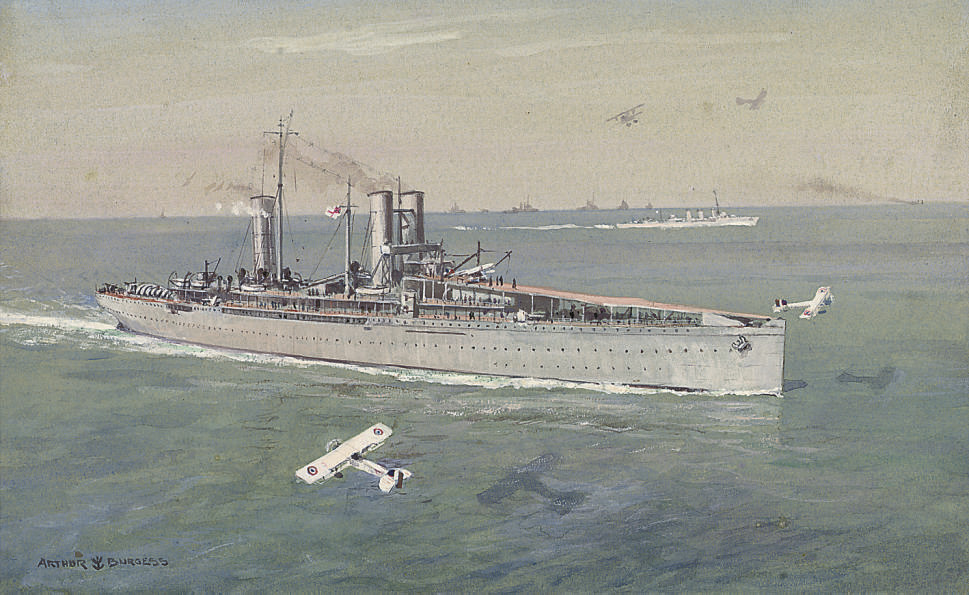
Design Genesis
An innovative translatlantic liner
This famous ship was a former, innovative transatlantic of 1891-93. She was built at Fairfield Shipbuilding and Engineering Co Ltd of Glasgow and was launched on 8th September 1892 but completed in 1894. Measuring 622.0′ x 65.2′ x 37.8′ for displacing 20,990 gross tons she entered service with the Cunard on her famous Transatlantic American line (Liverpool-NYC), earning the Blue Ribbond. It was retaken by her sister ship, the SS Lucania not long after and the record held until 1897. Both had a twin 5 cylinder vertical triple expansion engines generating 28,000 ihp. The SS Campania was the first Cunard liner fitted with the Marconi wireless telegraph.
Design Genesis
An innovative translatlantic liner
This famous ship was a former, innovative transatlantic of 1891-93. She was built at Fairfield Shipbuilding and Engineering Co Ltd of Glasgow and was launched on 8th September 1892 but completed in 1894. Measuring 622.0′ x 65.2′ x 37.8′ for displacing 20,990 gross tons she entered service with the Cunard on her famous Transatlantic American line (Liverpool-NYC), earning the Blue Ribbond. It was retaken by her sister ship, the SS Lucania not long after and the record held until 1897. Both had a twin 5 cylinder vertical triple expansion engines generating 28,000 ihp. The SS Campania was the first Cunard liner fitted with the Marconi wireless telegraph.
Design of the conversion
By October 1914 she was considered obsolete by her company and resold to brokers. She was saved by her immediate requisition by the RN in October 1914. She was to be used as an auxiliary cruiser at first, purchased for £32,500. The plans changed however towards the end of 1914. While she awaited demolition, the Admiralty stepped in, really at the last minute as steel was needed urgently for new constructions.
The first idea was to convert her to an armed merchant cruiser, with the additional benefit of carrying seaplanes that could be deployed around the escorted convoy. In theory she was the earliest escort aicraft carrier ever designed. The original idea was to use float-planes, to be lowered into/retrieved from the sea by a crane if weather permitted. The conversion was carried out at Cammell Laird shipyard, Birkenhead. Her interiors were completely gutted, all what was valuable was sold off at auction (a large part of her furnitures and equipments are still around in private collections) so that room was made inside, creating a hangar to store up to 14 aircraft. Externally the new space still sported the original portholes. She was also equipped with eight 4.7″ (120-mm) guns for self defence and act as auxiliary cruiser. Combined with her large size (believed to be a guarantee of survival) she was also as fast as any German cruiser.
Hull and general design (1914-15)
The hull was left mostly unchanged. Her conversion was however made in several steps over the war. At first, a 160-foot flying-off deck was mounted in top of the forward superstructure, above the newly created hangar. Cranes were installed on either side to transfer seaplanes between the water and hold. The latter had enough room for seven large seaplanes plus a space for maintenance and extra storage, and another space for 4 more, so 11 total or 14 with smaller models. This was more than any seaplane carrier in service with the RN during the war, including HMS Ark Royal (8 seaplanes).
The was even another secondary space aft of the forward hold, under the flight deck still large enough for four small seaplanes but access was difficult and extra manoeuvers were needed to lift them to the flight deck section or to store them back, both relatively long and necessitating a calm sea.
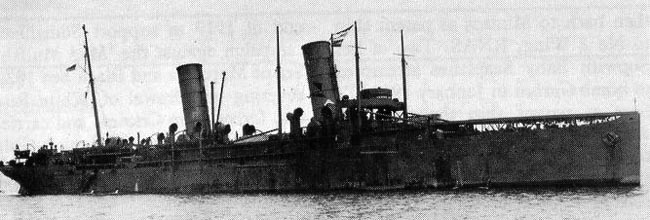
The HMS Campania in her first 1915 appearance, still with the relatively short flight deck and unchanged funnels.
As for dates, the acquisition for conversion started in late 1914 when renamed “HMS Campania”, but she was recommissioned in 1915. Trials took place under Captain Oliver Schwann, RN, and Charles H. Lightoller (from RMS Titanic) as “first officer” or XO. He was hired for the knowledge in handling these liners. Two weeks later, HMS Campania joined Scapa Flow and started fleet manoeuvres in the North Sea. Her first tactical training shifted, from escort to scout ahead to scout in search for the German fleet, so as “fleet carrier”.
Armament
She was fitted as auxiliary cruiser with a set of guns large enough to scare off destroyers and TBs, eight 4.7″ (120-mm) guns placed along her hull. Six were located on each wings, two at the bow, close to the forward hangar, two aft amidships, at the foot aft of the second funnel, before the rear hangar, and two at the poop. The location of the last two is uncertain. Navypedia on its side lists six of these QF Mk.I/II/III/IV -type unknown) instead, which seems obvious in rendition, and a sinlg e3-in or 76mm/45 AA installed probably in 1916 or 1917 aft, close to the two poop guns.
The 4.7 in guns were shielded, and weighted 4,704 lb (Mk IV) for a 189-inch bore (40 caliber), operated by 10 crew member. It fired separate loading QF AP, Shrapnel, Common Lyddite, Common pointed, or HE 45 pounds (20.41 kg) at 5–6 rounds per minute and 2,150 feet per second (660 m/s), up to 12,000 yards (11,000 m) at 24° elevation.
Air Group
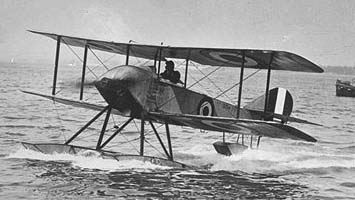 Sopwith Schneider: Her first model, the lightest seaplane in RNAS inventory, while highest-powered so perfect for close calls in favourable winds, but showing modifications were needed. Designed by Fred Sigrist, first flew in 1913, in service by 1914, had a Gnome Monosoupape 9 Type B-2 9-cyl. rotary engine 100 hp (75 kW).
Sopwith Schneider: Her first model, the lightest seaplane in RNAS inventory, while highest-powered so perfect for close calls in favourable winds, but showing modifications were needed. Designed by Fred Sigrist, first flew in 1913, in service by 1914, had a Gnome Monosoupape 9 Type B-2 9-cyl. rotary engine 100 hp (75 kW).
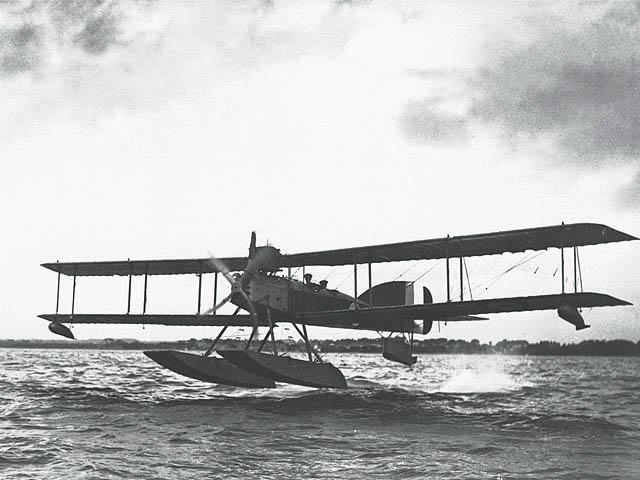
Short Type 184 torpedo bomber: She carried 7 of these after her second reconstruction in 1916. First flew in 1915, 936 built and used in several aviations until 1933, powered by a Sunbeam 260 hp (190 kW) for 88.5 mph (142.4 km/h, 76.9 kn) at 2,000 ft, carrying a single 14 in (356 mm) torpedo or 520 lb (236 kg) of bombs.
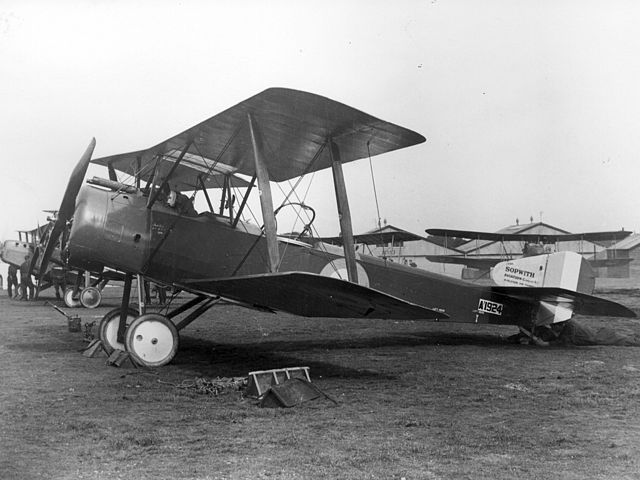
Sopwith 1/12 Strutter: Used as scouts. Excellent models powered by Clerget 9B 9-cylinder air-cooled rotary piston engines of 130 hp (97 kW), capable of 100 mph (160 km/h, 87 kn) at 6,500 ft (1,981 m) and of 3h hours autonomy. Standard on battleships’s platforms in 1918. Used as underrcarriage version, so they needed to land somewhere after launch.
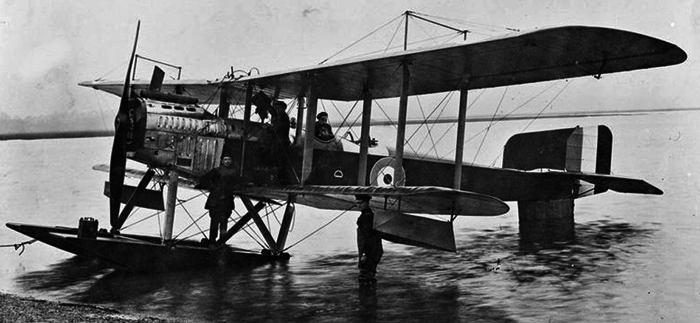
The Fairey Campania was named after the very ship for which she was designed. First flight on 16 February 1917, 62 built. Used a Sunbeam Maori II V-12 water-cooled piston engine for 260 hp (190 kW) and 85 mph (137 km/h, 74 kn) plus an atonomy of 4 hours 30 minutes. Could carry 6× 116 lb (53 kg) bombs under wings and fuselage, but no torpedo.
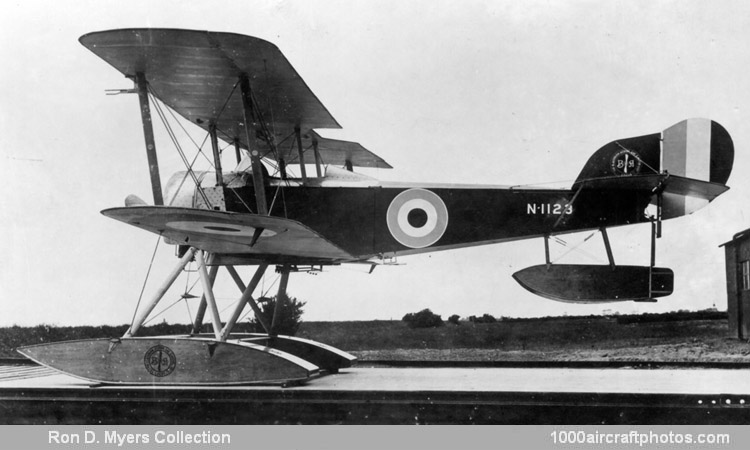
Sopwith Baby. Standard RNAS floatplane fighter, introduced Sept. 1915, had a Clerget 9Z 9-cylinder air-cooled rotary piston engine for 110 hp (82 kW) and 100 mph (160 km/h, 87 kn) at sea level able to stay aloft 2 hours 15 minutes. Used as escort for onboard Shorts and Campanias.
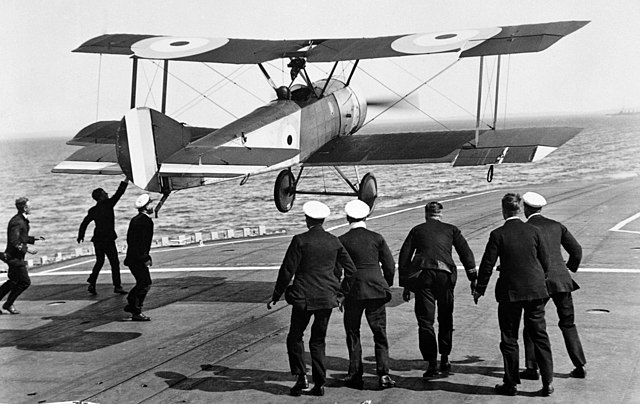
Sopwith Pup: The main RNAS fighter even after introduction of the Camel. Used on HMS Furious as well, but mostly for short periods on Campania. Powered by a Le Rhône 9C 9-cyl. air-cooled rotary piston engine, 80 hp (60 kW) and capable of 112 mph (180 km/h, 97 kn).

Unknown, c5000 nm
⚙ specifications |
|
| Displacement | 20,570 long tons (20,900 t) |
| Dimensions | 622 x 65 x 28 ft 5 in (189.6 x 19.8 x 8.7 m) |
| Propulsion | 2 shafts VTE steam engines 28,000 ihp (21,000 kW) |
| Speed | 19.5 knots (36.1 km/h; 22.4 mph) |
| Range | |
| Armament | 6× 4.7 in (120 mm) guns, one 3 in (76 mm) AA gun |
| Air group | 12 of various models, seaplanes, land planes |
| Facilities | Flying-off deck forward, 2 holds, cranes |
| Protection | ASW compartimentation, 7 Bulkheads and doors |
| Crew | 600 |
Career of HMS Campania
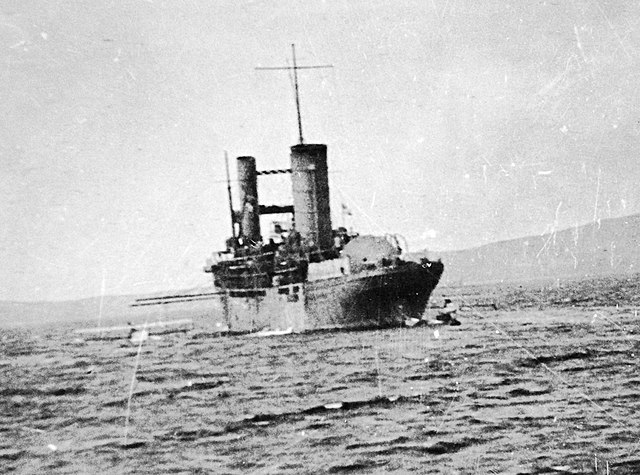
Stern view, in 1914, with still the funnels inline
HMS Campania was recommissioned on 17th April 1915. Her first flight was performed by a Sopwith Schneider in August. Mounted on a wheeled trolley, she was propelled in the wind while the ship was cruising at 17 knots; Despite of this the lightest and highest-powered RNAS model barely took off, showing the limits of the system. By October 1915 she started to operate with the Grand Fleet. In total she would perform a few missions, showing that taking off in rough seas with violent winds was detrimental for safety.
The first takeoff from her flight deck on 6 August 1915 was perform with a Sopwith Schneider floatplane, mounted on a wheeled trolley, a technique that was used for all launchings. It had to be retraived each time. The Sopwith used 130 feet (39.6 m) of the flight deck while steaming into the wind, at 17 knots (31 km/h; 20 mph). Speed is what made this ship handy. Originally Campania was able to reach 23.5 kts, but this was on trials in 1892. This demonstration was performed with the smallest model and this was not concluding for the admiralty.
By October 1915 she started exercizes with Grand Fleet, making seven of these missions, but only flown off aircraft three times due to North Sea weather. Her captain recommended to lengthen her flight deck, also with steeper slope, for gravity to boost acceleration when starting. She ship thus returned to Cammell Laird for a refit, starting in November 1915 and until early April 1916. This went further, under the supervision of the captain and pilots as well as handing crews:
-Forward funnel split into two funnels to make room below the bridge.
-Flight deck extended between the funnel, passing above the bridge to 245 feet (74.7 m) in lenght.
-Tracks made from rear hold to forward flight deck, to carry planes wings folded.
-Canvas windscreen provided to unfold wings out of the wind
-Kite balloon to sense the wind, and supporting equipment added in the aft hold.
-New provision of 7 Short Type 184 torpedo bombers, 3-4 Sopwith 1½ Strutter scouts.
Type 184 first takeoff was on 3 June 1916 with the same wheeled trolley. Since since was a large aircraft with military payload and true offensive capabilities, the Admiralty had her rebranded as an aircraft carrier for carrier operations, and ordered to Fairey a dericated model for military operations, the Fairey Campania. Designed and built in record time, they arrrived by late 1917, replacing the S184 and joined Sopwith Strutter scouts. She also operated at times in alternative the Sopwith Baby and Sopwith Pup with their undercarriage. Thus she truly became the world’s first truly operational aircraft carrier anywhere.
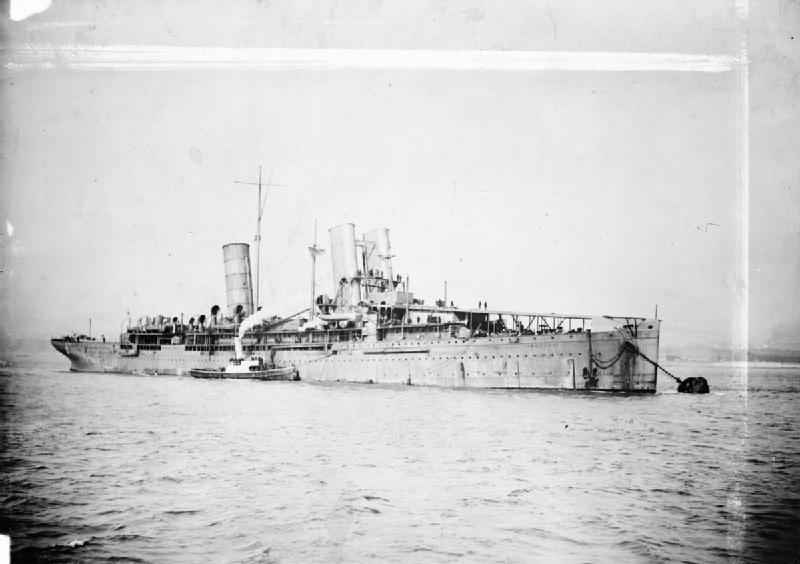
HMS Campania in 1916
Campania however stayed in Scapa when the Grand Fleet departed 30 May 1916 in what became the Battle of Jutland until ordered two hours and 15 minutes later. By 31 May she arrived, only to be ordered to return as lacking an escort with the danger of U-Boats, just reported in the area. Later HMS Campanian took part in several anti-submarine and anti-Zeppelin patrols but by early 1918, complaints about her worn out machinery (remarkable by 1892 by their size, but now obsolete and t the end of their rope). With HMS Furious entering service and many others coming about, she was reclassified as seaplane trainer, balloon depot ship. In April 1918 she was transferred to Rosyth.

HMS Campania in 1916, showing her modifications.

HMS Campania, camouflaged in 1918
By November 1918 the war was over and HMS Campania was moored in the Forth nearby HMS Glorious, HMS Royal Oak and HMS Royal Sovereign, off Burntisland, Fife. On the night of 4th November, Captain John J C Lindsay was in his cabin while Lieutenant Thomas Smart RNR was the Officer of the Middle Watch. It was a calm night, but around 03:00, a force 4-5 wind started to pull on the chains, and this evolved to a violent force 10 burst. This was enough to drag the Campania out of her position. The staff however failed to order the release of the secondary anchor, and at 03:35am, her flank met HMS Royal Oak’s bow on her port side at the dynamo compartment. Rapid flooding was limited by the use of watertight doors, but on the long run, failing to receive any assistance she sank by the stern, still deriving. It took five hours for her to finally sink upright near HMS Royal Sovereign, with no casualty on board as all had been evacuated.
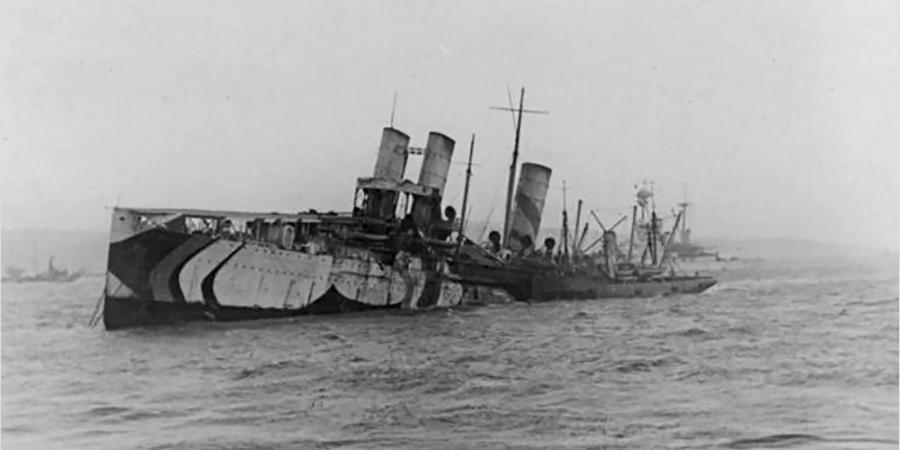
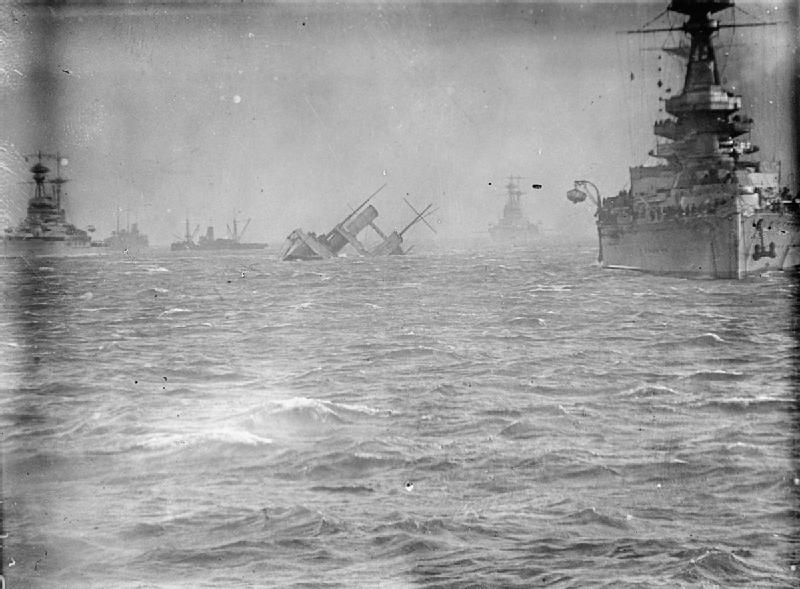
HMS Campania slowly sinking in the Firth of Forth on the early morning, 5 November.
Read More/Src
Links
IWM footage, Demonstration launching of a seaplane from HMS Campania at anchor in the Firth of Forth, 5th July 1918.
scottishshipwrecks.com
battleships-cruisers.co.uk
militaryfactory.com
wessexarch.co.uk
List of seaplane auxiliaries navypedia
flyingmachines.ru
en.wikipedia.org
Model Kits
The unique Polish AJM Models 1:700 model on scalemates. The airwing is 2 each of Short 184, Fairey Campania, Sopwith 1 1/2 Strutter, Sopwith Baby plus one balloon.

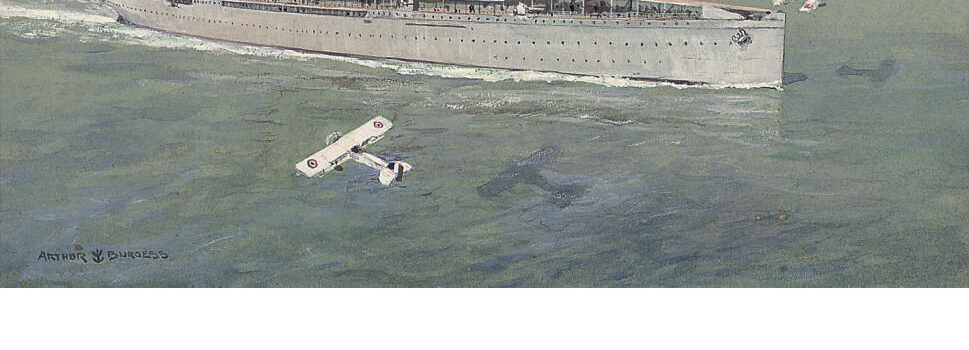
 Latest Facebook Entry -
Latest Facebook Entry -  X(Tweeter) Naval Encyclopedia's deck archive
X(Tweeter) Naval Encyclopedia's deck archive Instagram (@navalencyc)
Instagram (@navalencyc)





 Austrian Navy
Austrian Navy French Navy
French Navy Royal Navy
Royal Navy Armada Espanola
Armada Espanola K.u.K. Kriegsmarine
K.u.K. Kriegsmarine Dansk Marine
Dansk Marine Nautiko Hellenon
Nautiko Hellenon Koninklije Marine 1870
Koninklije Marine 1870 Marinha do Brasil
Marinha do Brasil Osmanlı Donanması
Osmanlı Donanması Marina Do Peru
Marina Do Peru Marinha do Portugal
Marinha do Portugal Regia Marina 1870
Regia Marina 1870 Nihhon Kaigun 1870
Nihhon Kaigun 1870 Preußische Marine 1870
Preußische Marine 1870 Russkiy Flot 1870
Russkiy Flot 1870 Svenska marinen
Svenska marinen Søværnet
Søværnet Union Navy
Union Navy Confederate Navy
Confederate Navy Armada de Argentina
Armada de Argentina Imperial Chinese Navy
Imperial Chinese Navy Marinha do Portugal
Marinha do Portugal Mexico
Mexico Kaiserliche Marine
Kaiserliche Marine 1898 US Navy
1898 US Navy Russkiy Flot
Russkiy Flot French Naval Aviation
French Naval Aviation Russian Naval Aviation
Russian Naval Aviation Sovietskiy Flot
Sovietskiy Flot Royal Canadian Navy
Royal Canadian Navy Royal Australian Navy
Royal Australian Navy RNZN Fleet
RNZN Fleet Chinese Navy 1937
Chinese Navy 1937 Kriegsmarine
Kriegsmarine Chilean Navy
Chilean Navy Danish Navy
Danish Navy Finnish Navy
Finnish Navy Hellenic Navy
Hellenic Navy Polish Navy
Polish Navy Romanian Navy
Romanian Navy Turkish Navy
Turkish Navy Royal Yugoslav Navy
Royal Yugoslav Navy Royal Thai Navy
Royal Thai Navy Minor Navies
Minor Navies Albania
Albania Austria
Austria Belgium
Belgium Columbia
Columbia Costa Rica
Costa Rica Cuba
Cuba Czechoslovakia
Czechoslovakia Dominican Republic
Dominican Republic Haiti
Haiti Hungary
Hungary Honduras
Honduras Estonia
Estonia Iceland
Iceland Eire
Eire Equador
Equador Iran
Iran Iraq
Iraq Latvia
Latvia Liberia
Liberia Lithuania
Lithuania Mandchukuo
Mandchukuo Morocco
Morocco Nicaragua
Nicaragua Persia
Persia San Salvador
San Salvador Sarawak
Sarawak Uruguay
Uruguay Venezuela
Venezuela Zanzibar
Zanzibar Warsaw Pact Navies
Warsaw Pact Navies Bulgaria
Bulgaria Hungary
Hungary

 Bundesmarine
Bundesmarine Dutch Navy
Dutch Navy Hellenic Navy
Hellenic Navy Marina Militare
Marina Militare Taiwanese Navy
Taiwanese Navy Chinese Navy
Chinese Navy Indian Navy
Indian Navy Indonesian Navy
Indonesian Navy JMSDF
JMSDF North Korean Navy
North Korean Navy Philippines Navy
Philippines Navy ROKN
ROKN IDF Navy
IDF Navy Royal New Zealand Navy
Royal New Zealand Navy Egyptian Navy
Egyptian Navy South African Navy
South African Navy

































 RN
RN
 Marine Nationale
Marine Nationale
 Soviet Navy
Soviet Navy
 dbodesign
dbodesign